Bill Pevlor
Gold In the Marsh
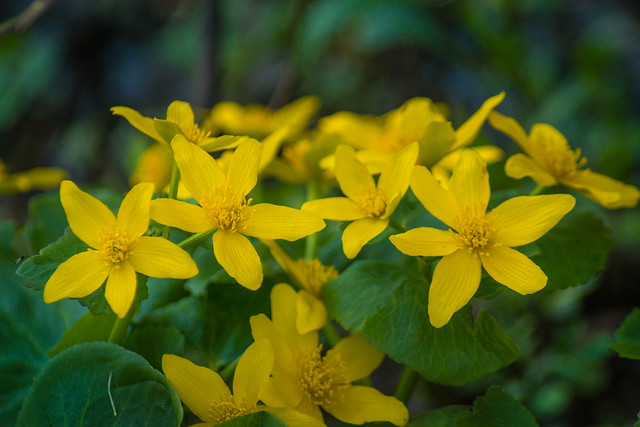
These yellow wildflowers are known locally as Marsh Marigolds. They can be found in ditches, wet woodlands and marshes. We found these…and a whole bunch more…in some soggy areas in the woodlands of northeast Wisconsin.
As I mentioned, we call them marsh marigolds in this area. Their botanical name is caltha palustris but they are known by a unbelievable variety of other names around the world. According to Wikipedia, the second most common name is kingcup. After that, they are also called brave bassinets, crazy Beth, horse blob, May blob, mare blob, boots, water boots, meadow-bright, bullflower, meadow buttercup, water buttercup, soldier’s buttons, meadow cowslip, water cowslip, publican’s cloak, crowfoot, water dragon, drunkards, water goggles, meadow gowan, water gowan, yellow gowan, goldes, golds, goldings, gools, cow lily, marybuds, and publicans-and-sinners. The common name “marigold” refers to its use in medieval churches at Easter as a tribute to the Virgin Mary, as in “Mary gold”.
All of the photos I post are available for purchase. If you’d like to buy one, click on the blue “Buy this Online” bar below for a variety of print and frame options or contact me for digital purchase and licensing options.
Out of the Blue
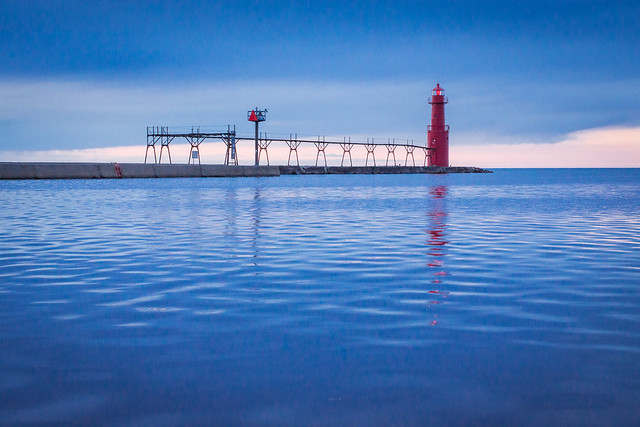
The deep red color of the Algoma lighthouse stands in sharp contrast to the deep blue of Lake Michigan and the early morning sky above.
I have taken a lot of photos of this lighthouse. On this trip, I was hoping for another nice sunrise. Unfortunately, the rising sun was concealed by a band of clouds on the horizon so a true sunrise photo wasn’t in the cards. I decided to catch a low angle view of the lighthouse across the Algoma harbor. To get this shot, I crawled down on the rocks near the mouth of the Ahnapee River, just off the marina parking lot, and held my camera just above the water.
I like this image for 1) the different perspective, 2) the reflection of the lighthouse, 3) the ripples in the water giving it depth and interest, and 4) the predominant blue color with contrasting red.
All of the photos I post are available for purchase. If you’d like to buy one, click on the blue “Buy this Online” bar below for a variety of print and frame options or contact me for digital purchase and licensing options.
Interloper
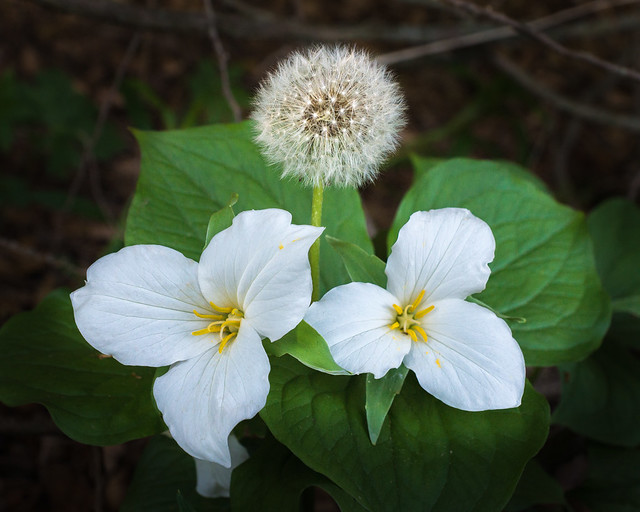
in·ter·lop·er
The dandelion is clearly the interloper here, inserting itself among the trilliums. These wildflowers were photographed on a recent hike in the woodlands of northeast Wisconsin.
I tried to capture the purity and details in the petals of the trillium blooms. The dandelion seemed to be photobombing. If you look closely, I think you can see a sly smirk on the dandelion’s face.
In any case, you can see all of the detail better by viewing the larger version. To do that, simply click on the photo.
All of the photos I post are available for purchase. If you’d like to buy one, click on the blue “Buy this Online” bar below for a variety of print and frame options or contact me for digital purchase and licensing options.
Tall Drink of Comfort
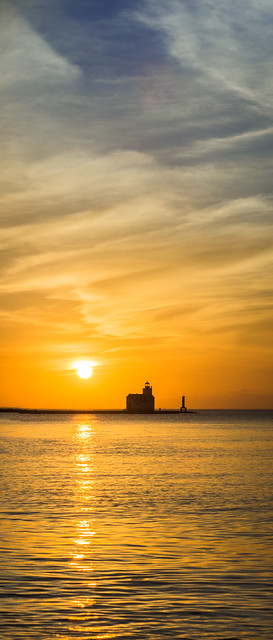 The sky above, the water below and the sun rising over its shoulder all combine to make a warm, comforting atmosphere around the Kewaunee, WI lighthouse. This image was captured on the western shore of Lake Michigan, just south of the pier in Kewaunee.
The sky above, the water below and the sun rising over its shoulder all combine to make a warm, comforting atmosphere around the Kewaunee, WI lighthouse. This image was captured on the western shore of Lake Michigan, just south of the pier in Kewaunee.
This is a panoramic image. Usually we think of panoramas as being wide, horizontal images. In this case, I wanted more of the sky and water in the shot than a single frame would allow, so I combined three frames (high, middle and low) to create a tall image. The changing hue in the upper sky adds to the interest of this image, as does the sun’s reflection dancing along the ripples of the lake.
As I’ve said before, I don’t normally post many panoramas because they don’t display well within the size constraints of most webpages. This one would be truly awesome if you could view it very large. It is a large file and could be printed as tall as eight feet. Wouldn’t that would be cool!
You can click on the image to view a larger version but, again, because of webpage constraints, you won’t see a much larger image.
All of the photos I post are available for purchase. If you’d like to buy one, click on the blue “Buy this Online” bar below for a variety of print and frame options or contact me for digital purchase and licensing options.
The Daffodil Patch
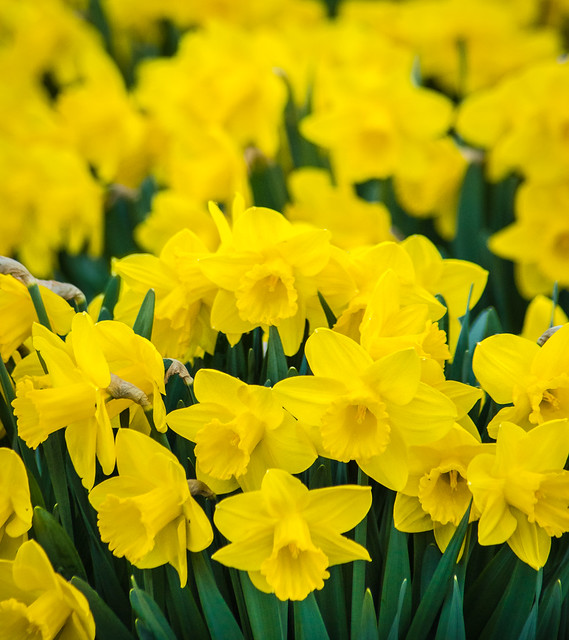 Daffodils are always a cheerful delight. Though short-lived, they are bright and vigorous springtime bloomers.
Daffodils are always a cheerful delight. Though short-lived, they are bright and vigorous springtime bloomers.
This particular patch is one of my favorite. Each spring, those driving north through Algoma,WI on highway 42 will find this plentiful display of yellow daffodils on the right side of the road, just before you descend the hill on the south side of town. My thanks and compliments to the homeowner who provide these well-cared-for beauties.
The daffodil is of the Narcissus genus – predominantly spring perennial plants in the Amaryllidaceae (amaryllis) family. Those in the Narcissus classification are easy to identify by their flowers with six petal-like tepals surmounted by a cup- or trumpet-shaped corona. According to Wikipedia, historical accounts suggest narcissi have been cultivated from the earliest times, but became increasingly popular in Europe after the 16th century and by the late 19th century were an important commercial crop centered primarily on the Netherlands. Today narcissi are popular as cut flowers and as ornamental plants in private and public gardens.
Like other members of their family, narcissi produce a number of different alkaloids, which provide some protection for the plant, but may be poisonous if accidentally ingested. This property has been exploited for medicinal use in traditional healing and has resulted in the production of galantamine for the treatment of Alzheimer’s dementia. Long celebrated in art and literature, narcissi are associated with a number of themes in different cultures, ranging from death to good fortune, and as symbols of spring. The daffodil is the national flower of Wales and the symbol of cancer charities in many countries.
You can view a larger version of this image by simply clicking on the photo.
All of the photos I post are available for purchase. If you’d like to buy one, click on the blue “Buy this Online” bar below for a variety of print and frame options or contact me for digital purchase and licensing options.
Fully Charged
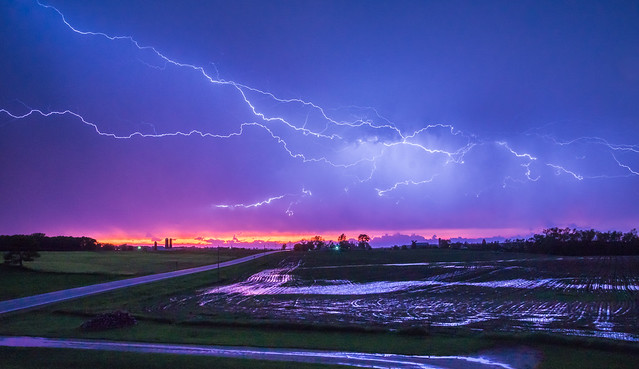
Lightning lit up the sky as a post script to the powerful storm that just rolled through our rural area of Kewaunee County in northeast Wisconsin.
A severe storm had just pushed through. On the horizon, the sky turned a wild, orangeish-red and the lightning continued to flash for awhile. I’m afraid I was a little late to the party. I should have gotten my camera out sooner. I was able to capture three shots with lightning – this, being the best one.
In the foreground you see the farm field, planted with corn in its early stages, soaked with water that reflects the brightness of the lightning. This shot was taken from a third-floor vantage point in the attic or our home. Very cool to watch.
This is one you’ll want to view in the larger version to see the fine detail in the lightning. You can do so by clicking on the image.
All of the photos I post are available for purchase. If you’d like to buy one, click on the blue “Buy this Online” bar below for a variety of print and frame options or contact me for digital purchase and licensing options.
Beyond the Harbor
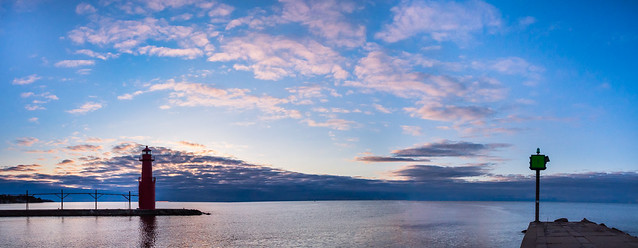
This is a panoramic view at the mouth of the harbor at Algoma, WI; on the western shore of Lake Michigan.
A couple of weeks ago I set out to capture a sunrise, but as you can see, the sun was blocked by the thick clouds on the horizon. The best feature of the morning were the lighter clouds, highlighted by the hidden sun, that filled the sky above.
To capture this wide-angle view, I took four separate photos and combined them for the final image you see here.
I don’t often post panoramic images because of the width limitations of most websites, including my own. To get the best view of this one, you should click on the photo. When you do, a larger version will open in a new browser tab.
All of the photos I post are available for purchase. If you’d like to buy one, click on the blue “Buy this Online” bar below for a variety of print and frame options or contact me for digital purchase and licensing options.
Heart On A String
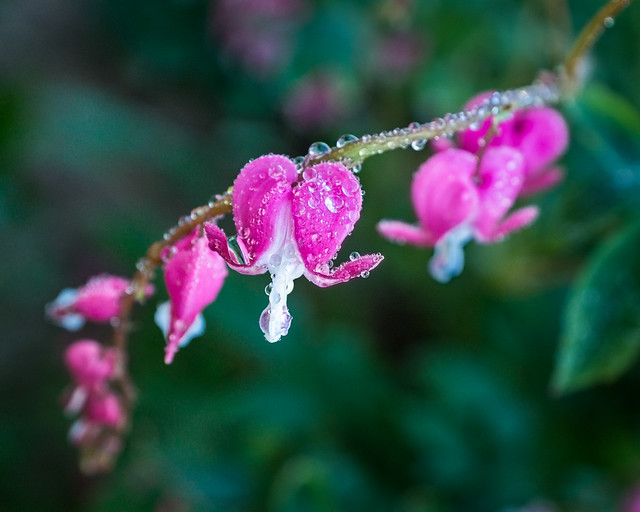
One of the most unique of flowers, this is the bleeding heart. It’s sparkling with moisture from a springtime rain.
The bleeding heart plant (lamprocapnos spectabilis) is native to China, Korea, Japan and Siberia. I was surprised to find out it is in the poppy family. It was brought to the west in the 1840s by the famed Scottish plant hunter, botanist Robert Fortune. It is prized by gardeners for its heart-shaped pink and white flowers that bloom in spring and early summer.
You can view a larger, more detailed version of this image by clicking on the photo.
All of the photos I post are available for purchase. If you’d like to buy one, click on the blue “Buy this Online” bar below for a variety of print and frame options or contact me for digital purchase and licensing options.
Wild Geranium Family Portrait
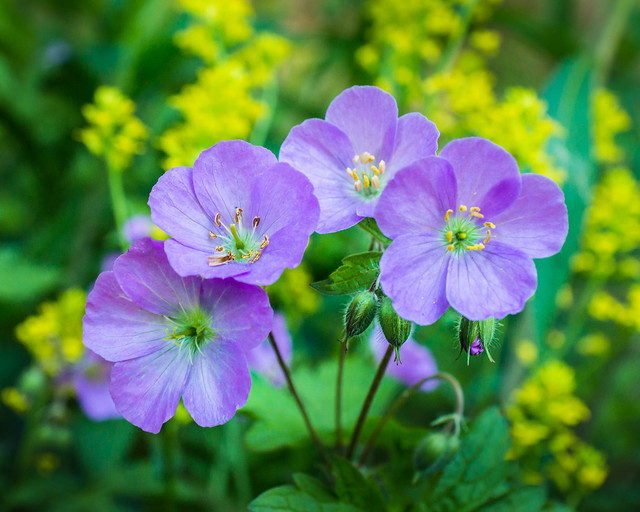
On a recent woodland hike I found this nice grouping of Wild Geraniums. It reminded me of a family portrait…parents and children…including little buds.
In the interest of full disclosure, I altered the background. There were some small, yellow wildflowers (weeds) growing a few feet away. I snapped off a stem of them and placed it behind my subjects to add a little more color and variety to the image.
As I often remind people, I operate as an artist not a photo journalist. Most images I post are true to the original scene. However, on occasion, I may add or subtract elements to suit my artistic vision. Most times, it’s done digitally. In this case, a little impromptu, on-site, floral arrangement.
You can get a better view by clicking on the photo. That will open a full-screen version in a new browser tab.
All of the photos I post are available for purchase. If you’d like to buy one, click on the blue “Buy this Online” bar below for a variety of print and frame options or contact me for digital purchase and licensing options.
In the Spotlight
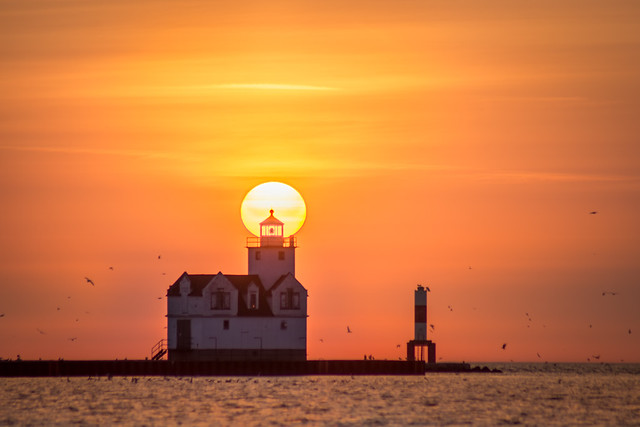
The calm of morning is accentuated by the warming hues of a sunrise, poised for effect, over the lighthouse at Kewaunee, WI.
It is difficult to grab the sun in just the right position because it’s always moving…and faster than you think. By the time I get into position and get the camera set, I have to adjust a few more inches to the left…and a few more inches down…and a few more inches…. Well, you get the idea. Try it sometime. It seems to be moving very slowly until you are trying to get a precise placement. Same problem with the moon on similar shots.
The other difficult aspect of this shot is trying to get some detail in the subject in front of the sun. With the overwhelming brightness of the sun, everything else can become a black, silhouette. The morning haze helped mute the brightness a bit. However, to get the level of definition you see in the lighthouse and navigation marker, I blended several shots of varying exposures.
You can view a full-screen version of this image by clicking on it.
All of the photos I post are available for purchase. If you’d like to buy one, click on the blue “Buy this Online” bar below for a variety of print and frame options or contact me for digital purchase and licensing options.


















































